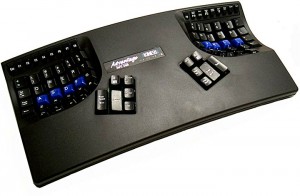Kinesis Advantage after four months
Update Nov 2021: It’s been eight years, I’m typing this on that original keyboard, it’s still my primary keyboard. What a beast. In my day job I have to also use a Mac, so I got a second Kinesis, this time with the Cherry MX Quiet Red switches. They are indeed quieter.
Update Dec 2018: It’s been five years and I still use that same Kinesis Advantage every day, all day and I still love it. I have commuted with it in my bike panniers, in my backpack, and carried it across several home moves: It’s solid. I switch easily between that and my laptop keyboard, my wrists and hands are healthy, I touch type faster than I can think. As I said five years ago: I’m not going back.
I have been using a Kinesis Advantage keyboard for the past four months, since August. I love it. Here’s my trip report.
Before this keyboard I had been using Microsoft Natural keyboards for many many years.
Let’s cut straight to the chase: The first three days were very hard. It’s the same feeling as when I switched to vim. You tell your fingers to do something and they don’t do it. It’s especially hard when you do lots of text chat. My typing rate went way down, so I couldn’t “talk” as fast.
After three days I was over the hump, and by the end of the first week I was comfortable. I went all in, not allowing myself to use any other keyboard during the first week. Now I type significantly faster than I did on the MS Natural, and can better type ‘blind’ (touch type) than I ever could before. The shape of the Kinesis means that you have to touch type.
I use the Kinesis primarily on my desktop, but also plugged in to my laptop. I use it from my standing desk and sitting. It’s pleasant to use from both.
I was surprised how compact the keyboard is; it takes about 10% less desk space than the MS Natural did. I have no problem switching back and forth between the Kinesis and my laptop keyboard – my brain can do both it seems.
Having luckily never had any injuries such as RSI or Carpal Tunnel, I can’t comment on it’s medical use. I credit never having had those partly to luck, and partly to the Microsoft Natural I used previously.
To use the Kinesis well with Linux, vim and tmux, I had to configure a few things:
Turn off the beeps: Progrm \ for the general one, and Progrm - for the caps-lock beep
Fix laptop power save: It’s a USB device, and my laptop was aggressively power-managing it, so if I stopped typing for more than 3 seconds it stopped working. To fix that:
lsusbto find the device id (it looks like03b2:0007)- Edit
/etc/laptop-mode/conf.d/usb-autosuspend.conf - Add the device id to
AUTOSUSPEND_USBID_BLACKLIST
Re-map some software keys: In Ubutu the windows key should open the panel, which wasn’t working by default. Also Alt-Tab on the Kinesis is almost impossible to press, so I replaced that with both Ctrl keys (which are right under your thumbs).
- Run
dconf-editor, expand toorg/gnome/desktop/wm/keybindings - Change
panel-main-menutoSuper_R(the Windows key) - Change
switch-windowsto<Primary>Control_R(both Ctrl keys at once)
In Ubuntu to find what a key sends open settings / keyboard / shortcuts and press the key. Remove the Mod part when putting into dconf-editor.
Re-map some hardware keys: Finally, programming needs a lot of Shift, so I swapped the Delete key (under the left thumb) with the right Shift (very bottom right). The kinesis allows you to swap any pair of keys very easily – instructions are printed on the bottom of the keyboard.
If you type a lot, and you can face the three-day learning curve, I highly recommend you upgrade to a Kinesis. I’m not going back.
